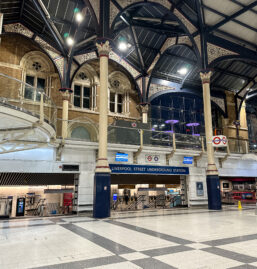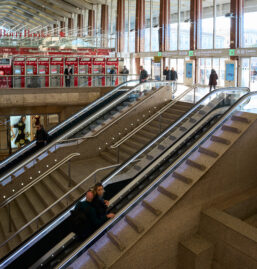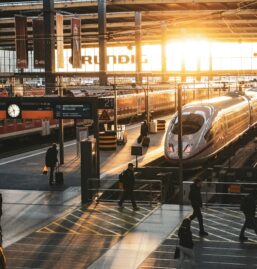
Rail travel is favored in Europe thanks to the efficiency of its train systems, its extensive network, and the scenic routes. It can provide a comfortable and unique way to explore diverse landscapes and countries – offering an immersive travel experience that is convenient and environmentally friendly, while connecting a range of destinations from major cities to charming towns.

Train Travel Accessibility – Evaluating Major Railway Nations
Omio are aware, however, that travelers with disabilities don’t always get to experience the same convenience and comfort they should. People with disabilities often face challenges with train services, including inaccessible platforms or a lack of assistive technologies.
That is why our team of mobility experts evaluated railway stations in 16 major European railway nations, with a particular focus on the current state of accessibility.

Our study examined major train stations in cities and smaller stations in the countryside to understand how easy it is for travelers to use the train system. We analyzed official data from railway network operators, combining it with firsthand observations. This approach allowed us to create a comprehensive overview of barrier-free train travel in Europe, and highlight country-specific challenges.
We believe that in a fast-moving world, access to barrier-free and accessible public railway services aren’t just a matter of convenience; it’s a fundamental right. When railway stations and trains are designed to include everybody, it empowers everybody. For people with disabilities it’s not just a matter of convenience, but it fosters social equality and opportunities for individuals with diverse needs.
Assessing barrier-free entry to platforms
Assessing barrier-free entry to platforms
For people with mobility disabilities, traveling abroad requires careful planning. While train travel is an excellent choice to explore various European destinations, not every railway station is fully equipped to meet the needs of travelers in wheelchairs or with other physical disabilities.
Sweden, Norway, and the Netherlands stand out as the most accessible railway nations, especially when it comes to access to platforms without steps or stairs. In Sweden and Norway, 99 percent of stations are accessible to people in wheelchairs, spanning from major cities like Stockholm and Oslo to smaller towns in the rural areas of Scandinavia. In the Netherlands, this percentage is still at an impressive high of 97 percent.
Countries like these demonstrate a commendable commitment to accessibility and inclusivity, catering to individuals with and without disabilities and fostering an environment of equal participation.
Regrettably, traveling in countries such as Belgium, Denmark, Czechia, and Italy can pose challenges for individuals with mobility disabilities. Our research reveals that only 1 in 4 or fewer railway stations in these countries are accessible. Notable exceptions include Brussels Midi, Copenhagen Central, Prague Main Station, and Rome Termini.
Accessibility Challenges for the Visually Impaired
Accessibility Challenges for the Visually Impaired
Navigating unfamiliar environments becomes significantly easier when public places are accessible and equipped with guidance for individuals who are visually impaired or blind. This aspect becomes particularly crucial when individuals seek to travel abroad independently.
Fortunately, guidance for the visually impaired, including tactile pavement on the floor, is widely available at European train stations. Notably, the Netherlands, Germany, and Ireland showcase nationwide accessibility, with 97 percent to 99 percent of platforms providing tactile pavements to navigate to departure platforms.
In Sweden, Norway, France, and Luxembourg, at least 9 in 10 platforms offer tactile guidance.
Denmark and Poland, on the other hand, emerge as the least accessible in this criterion. Only 22 percent of Danish railway stations are equipped with tactile pavement, while the number for Poland is even lower at 17 percent. These barriers significantly impact people’s ability to travel independently. However, assistance is available at Copenhagen Central and Warsaw Central when booked in advance.
Accessibility via Digital Passenger Information Displays
Accessibility via Digital Passenger Information Displays
Real-time passenger information on platforms through digital departure boards is beneficial for all travelers. Displays ensure that passengers are waiting for the right train on the correct track, and keep them informed about train delays or changes in schedules. For people who are hard of hearing or deaf, up-to-date visual information is an integral part of accessibility in travel.
Once again, the Netherlands is at the forefront of accessibility, with 99 percent of all platforms equipped with visual and digital passenger information, followed by Germany with 98 percent. Real-time updates on train service make traveling easier and more enjoyable for everybody.
In general, digital passenger information boards are widespread among European railway networks and stations. Countries like Ireland, Spain, Czechia, and Poland provide real-time travel information on 6 out of 10 platforms, which is less accessible compared to other European railway nations.
Reviewed: Busiest Railway Stations in Europe

European Union Promotes Broad Accessibility
The European Union is advocating for regulations on accessibility in public transport, particularly railways. These regulations stress the significance of accessibility and urge member states to implement measures ensuring equal participation in public transport for all. The Czech Republic’s placement in this ranking highlights the pressing need to adhere to these EU guidelines and enhance accessibility in railway transport.
Non-member states are responsible for establishing their priorities, with accessibility being a fundamental right. Norway serves as a role model in this regard, demonstrating high percentages across all three accessibility criteria analyzed.
The Most Accessible Railway Nations
Most wanted…
-
Rome Termini To Fiumicino Aeroporto Train
Paris Gare Du Nord To Paris Charles De Gaulle Airport Train
Milan Centrale To Courchevel 1850 Train
Berlin Hbf To Berlin Brandenburg Airport Train
Frankfurt (Main) Hbf To Frankfurt Am Main Airport Train
Rome Termini To Civitavecchia Train
Cologne Hbf To Cologne Bonn Airport Train
Milan Centrale To Malpensa T1 Train
Cologne Hbf To Frankfurt Am Main Airport Train
Florence Santa Maria Novella To Rome Leonardo Da Vinci Fiumicino Airport Train -
Paris Gare De Lyon To Paris Charles De Gaulle Airport Train
Milan Centrale To Bergamo Train
Rome Termini To Florence Train
Milan Centrale To Como San Giovanni Train
Milan Centrale To Zürich Hbf Train
Milan Centrale To Milan Bergamo Orio Al Serio Airport Train
Rome Termini To Naples Centrale Train
Milan Centrale To Paris Gare De Lyon Train
Rome Termini To Florence Santa Maria Novella Train
Paris Gare De Lyon To Milan Centrale Train









